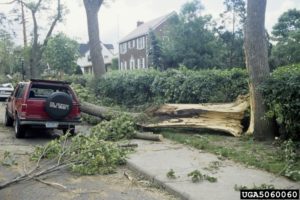The emerald ash borer (EAB) will kill nearly all of Wisconsin’s ash trees that are not protected by insecticides. If you have healthy ash trees in your yard, you have an important decision to make: protect your trees with insecticides or have them removed. Either way, time is of the essence. If you delay in treating your ash trees, the treatment may be less effective. And if you wait to remove them, removal costs will be greater and safety hazards will only get worse.

Credit: Joseph O’Brien, USDA Forest Service, Bugwood.org
What makes infested trees so dangerous?
The structural integrity, or strength, of ash branches and tree trunks begins to decline as soon as the tree becomes infested and the wood begins to dry. Lower moisture content increases the risk of branch and trunk breakage, and the timing of breakage is usually unpredictable. Infested trees may also have total trunk failure soon after death, further increasing the chance of dangerous impacts to people and property.
Why is it more expensive to remove a dead or declining tree?
Dry, weakened trees pose an increased safety risk not only to pedestrians and property, but also to arborists. Many professional tree services won’t let their arborists climb trees that show even 20% decline from EAB, so removing them often requires the use of expensive equipment. Removing an infested tree may cost twice as much as removing a healthy tree, and removing a dead tree may cost three times as much.

Credit: David Cappaert, Bugwood.org
If your tree looks healthy, you may be tempted to wait. Early signs and symptoms of infestation may appear minor, but don’t be fooled. Take action today!
For more information, view the DNR publication on the dangers and costs of infested ash trees. Urban forestry professionals may wish to share this flyer with homeowners who ask questions on these topics.
